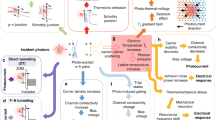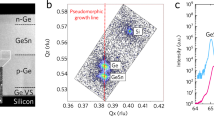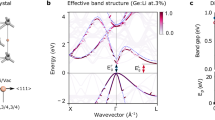Abstract
Although silicon has long been the material of choice for most microelectronic applications, it is a poor emitter of light (a consequence of having an ‘indirect’ bandgap), so hampering the development of integrated silicon optoelectronic devices. This problem has motivated numerous attempts to develop silicon-based structures with good light-emission characteristics1, particularly at wavelengths (∼1.5 μm) relevant to optical fibre communication. For example, silicon–germanium superlattice structures2 can result in a material with a pseudo-direct bandgap that emits at ∼1.5 μm, and doping silicon with erbium3 introduces an internal optical transition having a similar emission wavelength, although neither approach has led to practical devices. In this context, β-iron disilicide has attracted recent interest4,5,6,7,8,9,10,11,12 as an optically active, direct-bandgap material th might be compatible with existing silicon processing technology. Here we report the realization of a light-emitting device operating at 1.5 μm that incorporates β-FeSi2 into a conventional silicon bipolar junction. We argue that this result demonstrates the potential of β-FeSi2 as an important candidate for a silicon-based optoelectronic technology.
This is a preview of subscription content, access via your institution
Access options
Subscribe to this journal
Receive 51 print issues and online access
$199.00 per year
only $3.90 per issue
Buy this article
- Purchase on Springer Link
- Instant access to full article PDF
Prices may be subject to local taxes which are calculated during checkout





Similar content being viewed by others
References
Miller, D. A. Silicon sees the light. Nature 378, 238 (1995).
Forster, M.et al. Photoluminescence and photocurrent studies of Si/SiGe p–i–n heterostructures. J.Appl. Phys. 80, 3017–3023 (1996).
Zheng, B.et al. Room temperature sharp line luminescence at 1.5 microns from an erbium doped light emitting diode. Appl. Phys. Lett. 64, 2842–2844 (1994).
Christensen, N. E. Electronic structure of beta-FeSi2. Phys. Rev. B 42, 7148–7153 (1990).
Eppenga, R. Ab initio band structure calculation of the semiconductor beta-FeSi2. J. Appl. Phys. 68, 3027–3029 (1990).
Finney, M. S.et al. Effects of annealing and cobalt implantation on the optical properties of beta-FeSi2. Mater. Res. Soc. Symp. Proc. 316, 433–438 (1994).
Radermacher, K., Skeide, R., Carius, J., Klomfass, J. & Mantl, S. Electrical and optical properties of FeSi2 layers. Mater. Res. Soc. Symp. Proc. 320, 115–120 (1994).
Giannini, C., Lagopmarsino, S., Scarinci, F. & Castrucci, P. Nature of the bandgap of polycrystalline beta-FeSi2 films. Phys. Rev. B 45, 8822–8824 (1992).
Rosen, B. N. E.et al. Characterisation of beta-FeSi2/Si heterostructures grown by gas source MBE. Mater. Res. Soc. Symp. Proc. 320, 139–144 (1994).
Bost, M. C. & Mahan, J. E. Aclarification of the index of refraction of beta iron disilicide. J. Appl. Phys. 64, 2034–2037 (1988).
Bost, M. C. & Mahan, J. E. Optical properties of semiconducting FeSi2 films. J. Appl. Phys. 58, 2696–2703 (1985).
Dimitriadis, C. A.et al. Electronic properties of semiconducting FeSi2 films. J. Appl. Phys. 68, 1726–1734 (1990).
Sauer, R.et al. Dislocation related photoluminescence in silicon. Appl. Phys. A 36, 1–13 (1985).
Radermacher, K., Carius, R. & Mantl, S. Optical and electrical properties of buried semiconducting beta-iron disilicide S. Nucl. Instrum. Meth. B 84, 163–167 (1994).
Yang, Z., Homewood, K. P., Finney, M. S., Harry, M. & Reeson, K. J. Optical absorption study of ion beam synthesized polycrystalline semiconducting FeSi2. J. Appl. Phys. 78, 1958–1963 (1995).
Katsumata, H.et al. Optical absorption and photoluminescence studies of beta-FeSi2 prepared by heavy implantation of Fe+ions into silicon. J. Appl. Phys. 80, 5995–5962 (1996).
Leong, D., Harry, M., Reeson, K. J. & Homewood, K. P. On the origin of the 1.5 micron luminescence in ion beam synthesized beta-FeSi2. Appl. Phys. Lett. 68, 1649–1650 (1996).
Hunt, T. D.et al. Optical properties and phase transformations in alpha and beta iron disilicide layers. Nucl. Instrum. Meth. B 84, 168–171 (1994).
Reeson, K. J.et al. Electrical and optical properties of ion beam synthesised (IBS) FeSi2. J. Nucl. Instrum. Meth. B 106, 364–371 (1995).
Acknowledgements
We thank E. Parker and P. J. Phillips of the University of Warwick for growing the silicon p–n junction layers. This work was supported by the UK Engineering and Physical Sciences Research Council.
Author information
Authors and Affiliations
Corresponding authors
Rights and permissions
About this article
Cite this article
Leong, D., Harry, M., Reeson, K. et al. A silicon/iron-disilicide light-emitting diode operating at a wavelength of 1.5 μm. Nature 387, 686–688 (1997). https://doi.org/10.1038/42667
Received:
Accepted:
Issue Date:
DOI: https://doi.org/10.1038/42667
This article is cited by
-
Rethinking radiation effects in materials science using the plasma-focused ion beam
Journal of Materials Science (2022)
-
Fabrication and Physical Properties of Single-Crystalline Βeta-FeSi2 Nanowires
Nanoscale Research Letters (2020)
-
Observation of room-temperature superparamagnetic behavior of Fe5Si3 nanocrystals synthesized via 50 keV Fe ion implantation in silicon
Applied Physics A (2020)
-
Step-edge guided growth of nanowires on three-fold symmetric vicinal Si(111) surfaces
Bulletin of Materials Science (2020)
-
Fabrication of SrGe2 thin films on Ge (100), (110), and (111) substrates
Nanoscale Research Letters (2018)
Comments
By submitting a comment you agree to abide by our Terms and Community Guidelines. If you find something abusive or that does not comply with our terms or guidelines please flag it as inappropriate.



